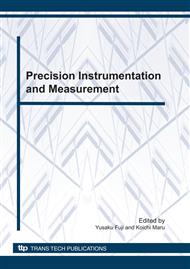[1]
K. Ohishi, K. Ohnishi and K. Miyachi: Torque-speed regulation of DC motor based on load torque estimation, Proc. IEEJ IPEC-TOKYO, Vol. 2 (1983), pp.1209-1216.
Google Scholar
[2]
S. Komada and K. Ohnishi: Force feedback control of robot manipulator by the acceleration tracing orientation method, IEEE Transactions on Industrial Electronics, Vol. 37, No. 1 (1990), pp.6-12.
DOI: 10.1109/41.45837
Google Scholar
[3]
T. Umeno and Y. Hori: Robust speed control of DC servomotors using modern two degrees-of-freedom controller design, IEEE Transactions on Industrial Electronics, Vol. 38, No. 5 (1991), pp.363-368.
DOI: 10.1109/41.97556
Google Scholar
[4]
M. Tomizuka: On the design of digital tracking controllers, Transactions of the ASME Journal of Dynamic Systems, Measurement, and Control, Vol. 115 (1993), pp.412-418.
DOI: 10.1115/1.2899081
Google Scholar
[5]
K. Ohnishi, M. Shibata and T. Murakami: Motion control for advanced mechatronics, IEEE/ASME Transaction on Mechatronics, Vol. 1, No. 1(1996), pp.56-67.
DOI: 10.1109/3516.491410
Google Scholar
[6]
H. S. Lee and M. Tomizuka; Robust motion controller design for high-accuracy positioning systems, IEEE Transactions on Industrial Electronics, Vol. 43, No. 1 (1996), pp.48-55.
DOI: 10.1109/41.481407
Google Scholar
[7]
T. Mita, M. Hirata, K. Murata and H. Zhang: control versus disturbance-observer-based control, IEEE Transactions on Industrial Electronics, Vol. 45, No. 3 (1998), pp.488-495.
DOI: 10.1109/41.679007
Google Scholar
[8]
H. Kobayashi, S. Katsura and K. Ohnishi: An analysis of parameter variations of disturbance observer for motion control, IEEE Transactions on Industrial Electronics, Vol. 54 (2007), No. 6 pp.3413-3421.
DOI: 10.1109/tie.2007.905948
Google Scholar
[9]
G. Zames: Feedback and optimal sensitivity: model reference transformations, multiplicative seminorms and approximate inverse, IEEE Transactions on Automatic Control, Vol. 26 (1981), pp.301-320.
DOI: 10.1109/tac.1981.1102603
Google Scholar
[10]
D.C. Youla, H. Jabr, J.J. Bongiorno: Modern Wiener-Hopf design of optimal controllers. Part I, IEEE Transactions on Automatic Control, Vol. 21 (1976), pp.3-13.
DOI: 10.1109/tac.1976.1101139
Google Scholar
[11]
C.A. Desoer, R.W. Liu, J. Murray, R. Saeks: Feedback system design: The fractional representation approach to analysis and synthesis, IEEE Transactions on Automatic Control, Vol. 25 (1980), pp.399-412.
DOI: 10.1109/tac.1980.1102374
Google Scholar
[12]
M. Vidyasagar: Control System Synthesis-A factorization approach- (MIT Press, 1985).
Google Scholar
[13]
M. Morari, E. Zafiriou: Robust Process Control (Prentice-Hall, 1989).
Google Scholar
[14]
J.J. Glaria, G.C. Goodwin: A parameterization for the class of all stabilizing controllers for linear minimum phase systems, IEEE Transactions on Automatic Control, Vol. 39 (1994), pp.433-434.
DOI: 10.1109/9.272352
Google Scholar
[15]
K. Yamada, I. Murakami, Y. Ando, T. Hagiwara, Y. Imai and M. Kobayashi: The parametrization of all disturbance observers, ICIC Express Letters, Vol. 2 (2008), pp.421-426.
DOI: 10.1109/iciea.2009.5138167
Google Scholar
[16]
K. Yamada, I. Murakami, Y. Ando, T. Hagiwara, Y. Imai, D.Z. Gong and M. Kobayashi: The parametrization of all disturbance observers for plants with input disturbance, The 4th IEEE Conference on Industrial Electronics and Applications, (2009).
DOI: 10.1109/iciea.2009.5138167
Google Scholar
[17]
C. N. Nett, C. A. Jacobson and M. J. Balas: A connection between state-space and doubly coprime fractional representation, IEEE Transactions on Automatic Control, Vol. 29 (1984), pp.831-832.
DOI: 10.1109/tac.1984.1103674
Google Scholar


